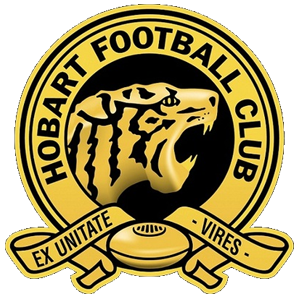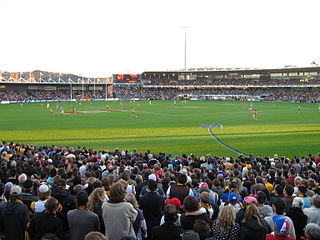Peter John HudsonAM is a former Australian rules footballer who played for the Hawthorn Football Club in the Victorian Football League (VFL) and for the New Norfolk Football Club and Glenorchy Football Club in the Tasmanian Australian National Football League (TANFL).

The Tasmanian State League (TSL), colloquially known as the Tasmanian Football League (TFL), was the highest-level Australian rules football competition in the state of Tasmania. It disbanded following the end of the 2024 season in preparation for the Tasmania Football Club to enter the Victorian Football League (VFL) in 2026.

Hobart Football Club is an Australian rules football club based in Hobart, Tasmania. They play their home fixtures at the TCA Ground on the Queens Domain, in Hobart and from 2014, the club has been a member of the Southern Football League after voting to withdraw from the Tasmanian State League at the end of the 2013 season after five seasons in that competition.

North Hobart Oval is a sports venue in North Hobart, Tasmania. Formerly used primarily for Australian rules football widely regarded as the traditional home of Australian football in Tasmania. However since the 1950s it has also become one of the main soccer, rugby league and rugby union venues in Tasmania.

In Tasmania, Australian rules football is a popular spectator and participation sport. It has been played since the late 1860s and draws the largest audience for any football code in the state. A 2018 study of internet traffic showed that 79% of Tasmanians are interested in the sport, the highest rate in the country. It is governed by AFL Tasmania and according to Ausplay there are 13,927 adult players with a participation rate of 2.5% per capita about a quarter of which are female playing across 12 competitions.

The North Hobart Football Club, nicknamed The Demons, is an Australian rules football club which plays in the Tasmanian State League. The club returned to the state league in 2018 after its position was effectively filled by a new club, the Hobart City Football Club after the 2013 season. The club was part of the Tasmanian Football League from the early 1900s through to 2001, where the club joined Southern Football League. In 2009, the club was invited into the second reincarnation of the statewide league where it remained until 2013.
Paul Sproule is a former Australian rules footballer who played for the Essendon Football Club and Richmond Football Club in the Victorian Football League (VFL), as well as for the Hobart Football Club and Sandy Bay Football Club in the Tasmanian Australian National Football League (TANFL). He also served brief stints as senior coach of Richmond, Hobart and Sandy Bay.
John Herbert Devine was an Australian rules footballer who played with Geelong in the Victorian Football League (VFL) during the 1960s, and Tasmanian Football League (TFL) side North Hobart between 1967 and 1974.
Malcolm Lawrence Pascoe was an Australian rules footballer and coach. He played 94 senior Victorian Football League (VFL) games for the Essendon Football Club from 1953 to 1958, and played 177 senior Tasmanian Australian National Football League (TANFL) games for the Hobart Football Club from 1959 to 1966. He was captain-coach of Hobart from 1959 to 1965, and non-playing coach of Hobart from 1978 to 1979.

West Park Oval is an Australian Rules football, cycling and athletics venue located on the shores of Bass Strait in Burnie, Tasmania. It is the current home of the Burnie Dockers in the Tasmanian State League and previously in the NTFL and in the original TFL Statewide League.
The Wynyard Football Club is an Australian rules football club based in Wynyard, Tasmania.
Burnet 'Burnie' Payne is a former Australian rules footballer who played for Hobart in the Tasmanian National Football League (TANFL) and St Kilda in the Victorian Football League (VFL). He is a member of the Tasmanian Football Hall of Fame, having been inducted in 2005.
The Tasmanian State Premiership was an Australian rules football tournament which was contested at the conclusion of the season, initially between the reigning Tasmanian Football League (TFL/TANFL) and Northern Tasmanian Football Association (NTFA) premiers, and then from 1950 also by the NWFU premiers, to determine an overall premier team for the state of Tasmania. The state premiership was contested 57 times between 1909 and 1978.

The Winfield Statewide Cup was an Australian rules football tournament held in Tasmania, Australia between the top twenty-one (21) major football clubs across Tasmania from the three major footballing bodies across the state, the TANFL, the NTFA and the NWFU.
The 2009 AFL Tasmania TSL premiership season was an Australian rules football competition, staged across Tasmania, Australia over eighteen roster rounds and six finals series matches between 4 April and 19 September 2009.
The 1993 TFL Statewide League premiership season was an Australian rules football competition staged across Tasmania, Australia over eighteen roster rounds and six finals series matches between 4 April and 18 September 1993.
The 1967 Tasmanian Australian National Football League (TANFL) premiership season was an Australian Rules football competition staged in Hobart, Tasmania over nineteen (19) roster rounds and four (4) finals series matches between 1 April and 16 September 1967.
Statewide Australian rules football competition has been played in Tasmania, Australia under the umbrella of the Tasmanian Football League from 1986–1998, Football Tasmania from 1999–2000 until the competition was disbanded in December 2000 and AFL Tasmania from 2009 when a new ten-club competition, this time known as the Tasmanian State League, was formed.
Victor Tasman Castles was an Australian rules footballer who played with South Melbourne in the Victorian Football League (VFL) during the 1940s.

The 1920 Victorian Football Association season was the 42nd season of the Australian rules football competition. The premiership was won by the Footscray Football Club, after it defeated Brunswick by 3 points in the final on 9 October. It was the club's seventh VFA premiership, drawing it level with Geelong for the most premierships in VFA history, and it was the club's second consecutive premiership.








